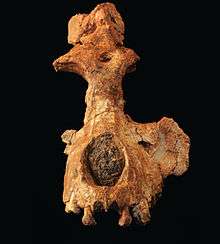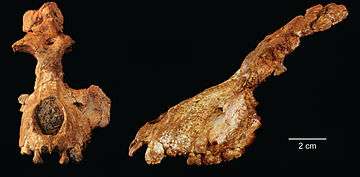Saadanius
Saadanius is a genus of fossil primate dating to the Oligocene that is closely related to the common ancestor of the Old World monkeys and apes, collectively known as catarrhines. It is represented by a single species, Saadanius hijazensis, which is known only from a single partial skull tentatively dated between 29 and 28 million years ago. It was discovered in 2009 in western Saudi Arabia near Mecca and was first described in 2010 after a comparison with both living and fossil catarrhines.
| Saadanius | |
|---|---|
 | |
| Saadanius hijazensis | |
| Scientific classification | |
| Kingdom: | Animalia |
| Phylum: | Chordata |
| Class: | Mammalia |
| Order: | Primates |
| Suborder: | Haplorhini |
| Infraorder: | Simiiformes |
| Parvorder: | Catarrhini |
| Superfamily: | †Saadanioidea Zalmout et al., 2010 |
| Family: | †Saadaniidae Zalmout et al., 2010 |
| Genus: | †Saadanius Zalmout et al., 2010 |
| Species: | †S. hijazensis |
| Binomial name | |
| †Saadanius hijazensis Zalmout et al., 2010 | |
Saadanius had a longer face than living catarrhines and lacked the advanced frontal sinus found in living catarrhines. However, it had a bony ectotympanic and teeth comparable to those of living catarrhines. The discovery of Saadanius may help answer questions about the evolution and appearance of the last common ancestors of Old World monkeys and apes.
Discovery

Saadanius is known from a single specimen, the holotype, named "SGS-UM 2009-002", stored in Jeddah, Saudi Arabia, at the Paleontology Unit of the Saudi Geological Survey (SGS). Its type locality was on top of an oolitic ironstone fossil bed of the middle Shumaysi Formation located in the southwest corner of Harrat Al Ujayfa, in western Saudi Arabia, close to Mecca.[1] The specimen was discovered in February 2009[2] by paleontologist Iyad Zalmout, who had traveled to the region to search for ancient whale and dinosaur fossils. While looking for dinosaur fossils in an area that, according to the maps he was working from, contained rock layers that dated to the Cretaceous, Zalmout found the jawbone of an anthracotheriid, which dated to the Eocene or Oligocene. This indicated that the rock layers were much younger than what was dated on the maps. The following day, he noticed fossil teeth, which he immediately recognized as those of a primate. Zalmout emailed a photo of the teeth to paleontologist Philip D. Gingerich, with whom he was working as a postdoctoral fellow. Gingerich, an expert on ancient primates and whales, confirmed that it was indeed a primate. Due to a tight schedule, Zalmout had to leave the exposed fossil embedded in the rock for the next few days because collecting it would require days of work.[3] The fossil was soon recovered by a joint expedition involving the SGS and the University of Michigan.[1]
The fossil was not formally described until 2010 when its discovery was announced in the journal Nature.[2] The fossil was dated to about 28 or 29 million years ago based on comparisons of fossils of anthracotheriids and paenungulates found nearby with fossils from similarly aged African deposits.[1][4] However, the date has yet to be confirmed by other dating techniques.[4] The genus name, Saadanius, comes from the Arabic word, saadan (Arabic: سَعدان), which is the collective term for apes and monkeys. The species name, hijazensis, is a reference to the al Hijaz region, in which it was discovered.[1]
Type specimen

Saadanius had a longer face than living catarrhines,[4] more closely resembling New World monkeys in appearance, although it was larger—possibly the size of a gibbon.[5] Its enlarged, deep-rooted canine teeth, the diastema between its canine teeth and second incisors, and its sagittal crest suggest that the specimen was a male.[1] These features are shared among male Old World monkeys.[2] Saadanius lacks the advanced frontal sinus found in living catarrhines,[1][2][4] but it does possess an ectotympanic, found in living catarrhines. Propliopithecoids, the oldest stem group of catarrhines, which date back 35 to 30 mya, lacked a fully developed ectotympanic.[1][4]
The specimen had serious puncture wounds on the front of the skull, indicating that it had been preyed upon by a large carnivore.[2] One puncture wound was on the right side of the braincase and may have been the fatal blow. There was also a bite mark on the frontal trigone.[1]
Like other catarrhine primates, Saadanius was probably a tree-dweller.[5] During the time it would have lived, the Red Sea had not yet formed, and new plant and animal species would have been arriving from nearby Eurasia as it converged with the Afro-Arabian landmass.[2]
Phylogeny and significance
| Saadanius placement within the catarrhine clade[1] | ||||||||||||||||||||||||
|
Comparative anatomy and cladistic analysis indicate that Saadanius is more closely related to the last common ancestor of crown catarrhines than any other known fossil catarrhines, placing the common ancestry of Catarrhini in Arabia and Africa. Other stem catarrhines include propliopithecoids, such as Aegyptopithecus, and pliopithecoids, such as Pliopithecus. The closer similarities between Saadanius and crown catarrhines, particularly its ectotympanic, suggest Saadanius of all known fossil primates most closely resembled the last common ancestor of living catarrhines.[1] Its discovery has provided new details about human evolution, particularly the split between the Old World monkeys and the ape lineage that eventually led to humans.[5]
The discovery of Saadanius provides new evidence for competing hypotheses about the facial appearance of the ancestral crown catarrhines, or common ancestor. One reconstruction is based on living catarrhine traits and predicts a short face and a rounded braincase, similar to that of a gibbon. Another reconstruction, based on the morphology of early Miocene apes and the basal cercopithecoid Victoriapithecus, predicts that the last common ancestor had a projecting snout and tall face, like that of living baboons and the oldest fossil apes and Old World monkeys. The conservative features of Saadanius, similar to those of the older stem catarrhines, support the latter hypothesis, according to Zalmout et al.[1][4][3] However, one palaeontologist, Eric Delson, has cautioned that geological pressure may have distorted the shape of the skull.[4]
According to Zalmout et al., Saadanius may also help resolve the age of the hominoid–cercopithecoid split.[1][4] Paleoanthropological work has typically placed the divergence between 25 and 23 mya, but genetic-based estimates have placed it in the early Oligocene, approximately 33 mya. Despite the predictions from the genetic tests, little fossil evidence has been found for a last common ancestor between 30 and 23 mya, favoring a later split. Only isolated teeth of Kamoyapithecus hinted at the existence of potential basal hominoids in the late Oligocene (between 24 and 27.5 mya),[1][5] while the oldest fossil Old World monkey, Victoriapithecus macinnesi, dates to 19 mya.[6] With the discovery of Saadanius, Zalmout et al. suggested a later split than the genetic data, dating between 29–28 and 24 mya.[1][5] However, Pozzi et al. later argued that although Saadanius is a significant discovery, because it is a stem catarrhine, it could not be used to date the divergence of the crown group. The presence of stem taxa in the fossil record does not indicate that crown groups have evolved, and stem taxa may survive for millions of years after the crown taxa appear. For this reason, the fossil record can only suggest a hard minimum boundary for divergence dates, which corresponds to the first appearance of a crown taxon. Furthermore, Pozzi et al. pointed out that the supplementary material published by Zalmout et al. demonstrated that Pliopithecoidea were more closely related to living catarrhines than Saadanius.[6]
The fossil find has also been seen by the SGS as an important find for Saudi Arabia, because it enriches the fossil record for the region. As a result of the find, both the SGS and the University of Michigan are considering more collaborative field explorations in the country.[3]
References
- Zalmout, I. S.; Sanders, W. J.; MacLatchy, L. M.; Gunnell, G. F.; Al-Mufarreh, Y. A.; Ali, M. A.; Nasser, A. -A. H.; Al-Masari, A. M.; Al-Sobhi, S. A.; Nadhra, A. O.; Matari, A. H.; Wilson, J. A.; Gingerich, P. D. (2010). "New Oligocene primate from Saudi Arabia and the divergence of apes and Old World monkeys". Nature. 466 (7304): 360–364. Bibcode:2010Natur.466..360Z. doi:10.1038/nature09094. PMID 20631798.
- Sample, I. (14 July 2010). "Ape ancestors brought to life by fossil skull of 'Saadanius' primate". The Guardian.
- Ross-Flanigan, N. (14 July 2010). "Fossil find puts a face on early primates". University of Michigan News Service.
- Laursen, L. (14 July 2010). "Fossil skull fingered as ape–monkey ancestor". NatureNews. doi:10.1038/news.2010.354.
- Ghosh, P. (14 July 2010). "Fossil links humans and monkeys". BBC News. Archived from the original on 15 July 2010.
- Pozzi, L.; Hodgson, J. A.; Burrell, A. S.; Disotell, T. R. (2011). "The stem catarrhine Saadanius does not inform the timing of the origin of crown catarrhines" (PDF). Journal of Human Evolution. 61 (2): 209–210. doi:10.1016/j.jhevol.2011.02.008. PMID 21497373.
External links
| Wikinews has related news: |
- A piece in the monkey puzzle – A short video from Nature explaining the Saadanius discovery and its significance.